Add this eBook to your basket to receive access to all 3,707 records. Our indexes include entries for the spelling cook. In the period you have requested, we have the following 3,707 records (displaying 3,441 to 3,450): These sample scans are from the original record. You will get scans of the full pages or articles where the surname you searched for has been found. Your web browser may prevent the sample windows from opening; in this case please change your browser settings to allow pop-up windows from this site. In police custody at Chichester in Sussex
(1923)
The Police Gazette was published by Authority by the London Metropolitan Police, and circulated, as confidential, to the police forces throughout Britain and Ireland. The contents were based on the information routinely submitted to the Criminal Record Office. One of the regular features was a section entitled Persons in Custody, in which each police force gave details of people taken into custody on remand or awaiting trial. The name of the arresting force is given, with duration of remand &c., and nature of charge; then the full name of the suspect (in bold), the C. R. O. number; year of birth; height; complexion; colour of hair; colour of eyes; occupation; birthplace; and details of previous convictions. Variations of surname spelling and aliases are noted in the descriptions, and these variants and aliases have also been indexed. | Sample scan, click to enlarge
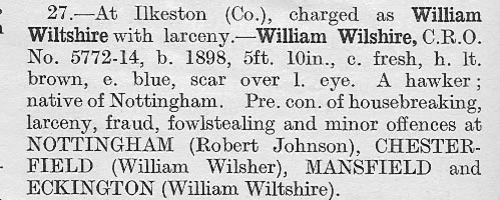
| In police custody at Gainsborough in Lincolnshire
(1923)
The Police Gazette was published by Authority by the London Metropolitan Police, and circulated, as confidential, to the police forces throughout Britain and Ireland. The contents were based on the information routinely submitted to the Criminal Record Office. One of the regular features was a section entitled Persons in Custody, in which each police force gave details of people taken into custody on remand or awaiting trial. The name of the arresting force is given, with duration of remand &c., and nature of charge; then the full name of the suspect (in bold), the C. R. O. number; year of birth; height; complexion; colour of hair; colour of eyes; occupation; birthplace; and details of previous convictions. Variations of surname spelling and aliases are noted in the descriptions, and these variants and aliases have also been indexed. | Sample scan, click to enlarge
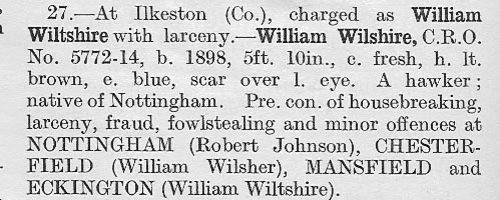
| Naturalizations
(1923)
The Home Office issued monthly lists of aliens to whom Certificates of Naturalization had been granted by the Secretary of State and whose oaths of allegiance had been registered in the Home Office. These notices, from January to December 1923, refer to naturalizations from December 1922 to November 1923. The lists give full name (surname first) with any aliases; country of origin; occupation; full postal address; date of taking the oath. A dagger indicates re-admission to British nationality; an asterisk that the person had served in H.M.'s Forces. | Sample scan, click to enlarge
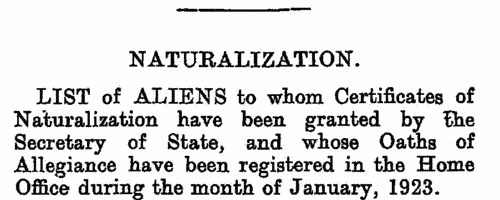
| Photographs of persons wanted by the police in Cheshire
(1923)
The Police Gazette was published by Authority by the London Metropolitan Police, and circulated, as confidential, to the police forces throughout Britain and Ireland. The contents were based on the information routinely submitted to the Criminal Record Office. One of the regular features was a section entitled Apprehensions Sought, in which each police force gave details of people for whom arrest warrants had been issued and were now on their Wanted list. The details given are: the name of the police authority (in bold) seeking an arrest; a brief description of the crime; the suspect's full name (in bold); C. R. O. number, year of birth, height, complexion, hair colour, eye colour, distinguishing marks such as scars; clothing &c. There then follows a resume of previous convictions. It was then sometimes additionally thought worthwhile to publish photographs of the wanted person: these do not repeat the details given in the original Wanted notice, but merely give the number and date of that item. Variations of surname spelling and aliases are noted in the descriptions, and these variants and aliases have also been indexed. This is the index to the photographs. | Sample scan, click to enlarge
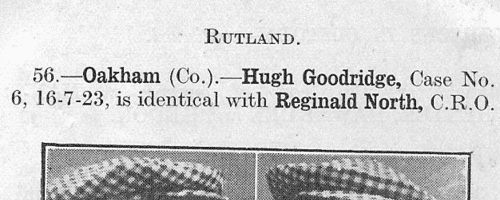
| Wanted by the police in Flintshire
(1923)
The Police Gazette was published by Authority by the London Metropolitan Police, and circulated, as confidential, to the police forces throughout Britain and Ireland. The contents were based on the information routinely submitted to the Criminal Record Office. One of the regular features was a section entitled Apprehensions Sought, in which each police force gave details of people for whom arrest warrants had been issued and were now on their Wanted list. The details given are: the name of the police authority (in bold) seeking an arrest; a brief description of the crime; the suspect's full name (in bold); C. R. O. number, year of birth, height, complexion, hair colour, eye colour, distinguishing marks such as scars; clothing &c. There then follows a resume of previous convictions. Variations of surname spelling and aliases are noted in the descriptions, and these variants and aliases have also been indexed. | Sample scan, click to enlarge

| Boys entering Loretto School
(1924)
The Reverend Dr Thomas Langhorne, who came to Musselburgh in Midlothian as an Episcopalian Church clergyman, established a small school for boarders and day scholars at Loretto House, so called because the grounds contained the ruins of the mediaeval chapel of St Mary of Loretto. To celebrate the centenary of the school in 1925, a second edition of the school register was published, edited by A. H. Buchanan-Dunlop. Relatively little was known of many of the earliest scholars, but from 1835 onwards the register generally gives full name, in capitals, surname first; date of birth; period of time at Loretto; a brief biography; date of death; whether brother of any other boy in the register; and a sequential number. | Sample scan, click to enlarge
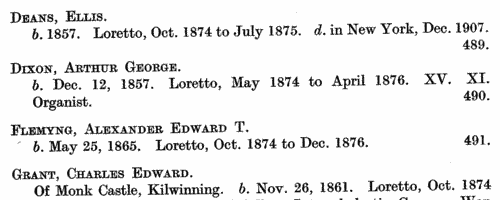
| Naturalizations
(1925)
The Home Office issued monthly lists of aliens to whom Certificates of Naturalization had been granted by the Secretary of State and whose oaths of allegiance had been registered in the Home Office. These notices, from January to December 1925, refer to naturalizations from December 1924 to November 1925. The lists give full name (surname first) with any aliases; country of origin; occupation; full postal address; date of taking the oath. A dagger indicates re-admission to British nationality. | Sample scan, click to enlarge
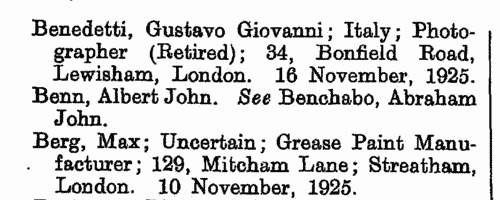
| Boys entering Epsom College
(1926)
The Royal Medical Benevolent College at Epsom in Surrey was founded in 1853 for the orphans of the medical profession, and evolved to become a public school still largely catering for sons of doctors and surgeons. In 1955 this register of pupils, from 1855 to 1954, edited by T. R. Thomson, was published. The sample scan is from 1880. The entries are arranged alphabetically by surname under year of entrance to the school; surname first (in bold), christian names, and then (in most cases), the father's name, occupation and address: then the boy's year of birth (b.), year of leaving (l.), occupation, and, where known, year of death (d.). From 1880 onwards the house to which the boy belonged is also indicated: the boarding houses were Carr (C.), Forest (F.), Granville (G.), Holman (H.), Propert (P.) and Wilson (W.); and Crawfurd (Cr.), Hart Smith (H. S.) and Rosebery (R.) are the houses for day scholars. From 1895 to 1927 there was a junior school, called Lower School (L. S.), taking in boys from the age of 8, many passing seamlessly into the main school at age 12 to 14. From 1920 onwards the pupils' addresses as of 1955 (where living and still known) are added at the end of each entry. This is the index to the year 1926, when the Reverend Canon Arnold Cecil Powell was headmaster. | Sample scan, click to enlarge

| Boys entering Marlborough College
(1926)
The public school at Marlborough in Wiltshire was founded in 1843. In 1952 this, 9th, edition of the college register was published, being a revision by L. Warwick James of the 8th edition (of 1936): but for the years before 1936 it does not merely repeat the 8th edition, because Warwick James was able to correct the 19th-century entries with information from newly-discovered letters and books from 1843 to 1853, and the school lists from 1844 onwards. The roll is arranged by year, and within each year by term of entrance, and then alphabetically by surname within each term. Each boy is assigned a number within the year: then his name is given, surname first, and, in brackets, his house. The houses within the college were called B1, B2, B3, C1, C2 and C3, and the Lower School (L Sch); the out college houses were Preshute, Priory, Cotton, Hermitage, Littlefield, Barton Hill, Summerfield and Upcot. Then there is given the boy's father's name (surname and initials) and address (at entrance), the boy's date of birth (b) and month of leaving (l). Where the boy represented the school at Rugby football (XV) or cricket (XI), in the rifle corps (VIII, or RC XI), that is indicated. There is a brief summary of achievements in later life, and, where known, and date of death or (in italics) address as in 1952. | Sample scan, click to enlarge
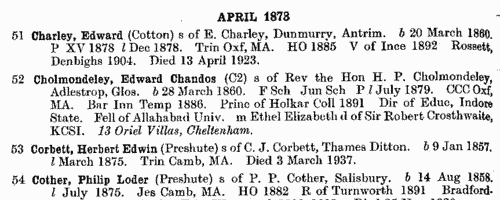
| Medical Practitioners in Ireland
(1926)
The Medical Directory was split into several sections. The Irish section covered all medical practitioners resident within the whole of the island of Ireland. Each year a schedule was sent to each doctor to be returned to the publishers, so as to keep the directory up to date. In the directory the doctor's name is given first, in bold, surname first, in capitals; then current address. Next are the qualifications; the italic abbreviations in parentheses following the qualifications indicate the medical school at which they were gained. Then there is a list of posts and honours within the profession, starting with those then current; previous posts are preceded by the word 'late'. Finally, brief details are given of any publications. | Sample scan, click to enlarge

|
Research your ancestry, family history, genealogy and one-name study by direct access to original records and archives indexed by surname.
|











